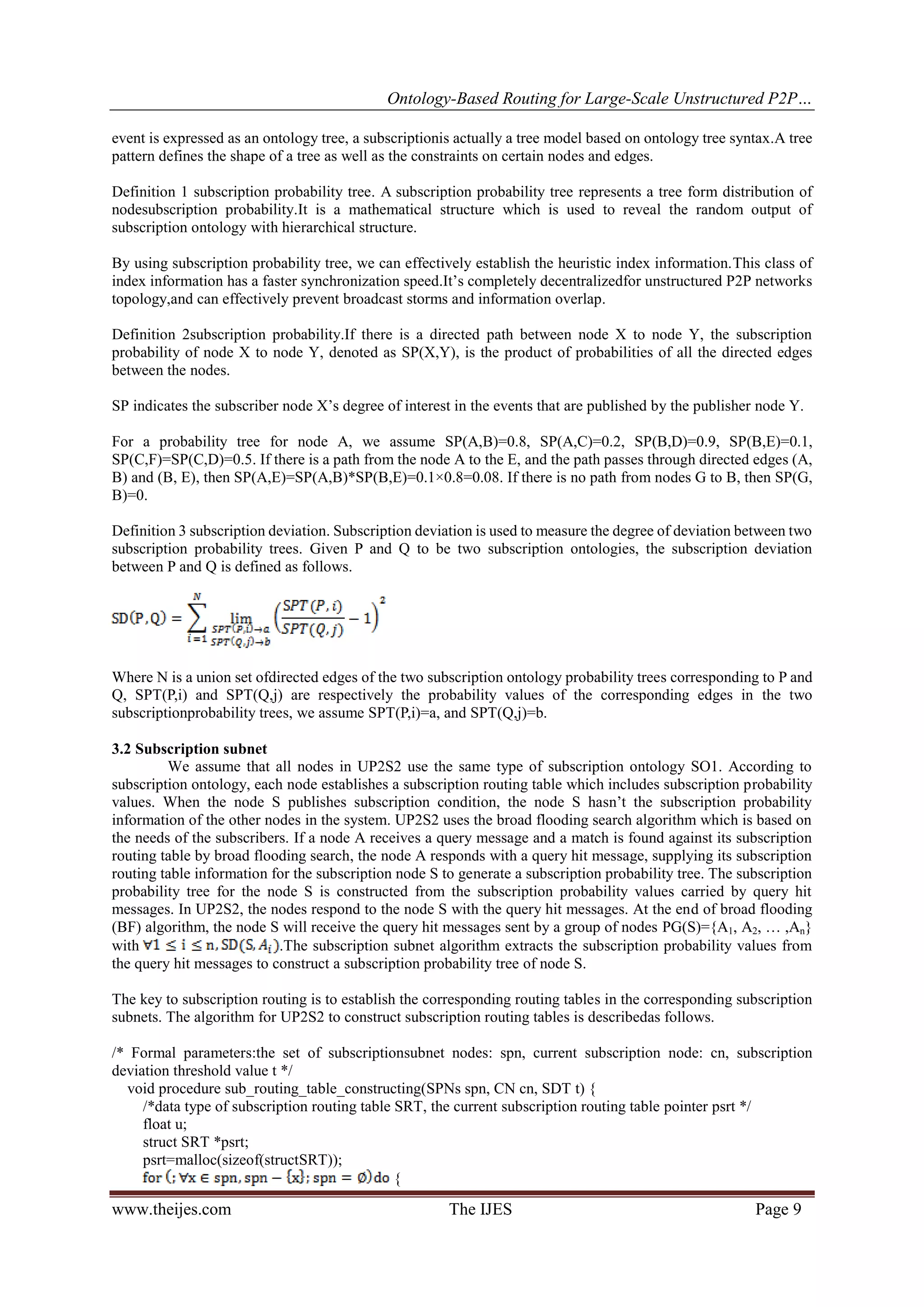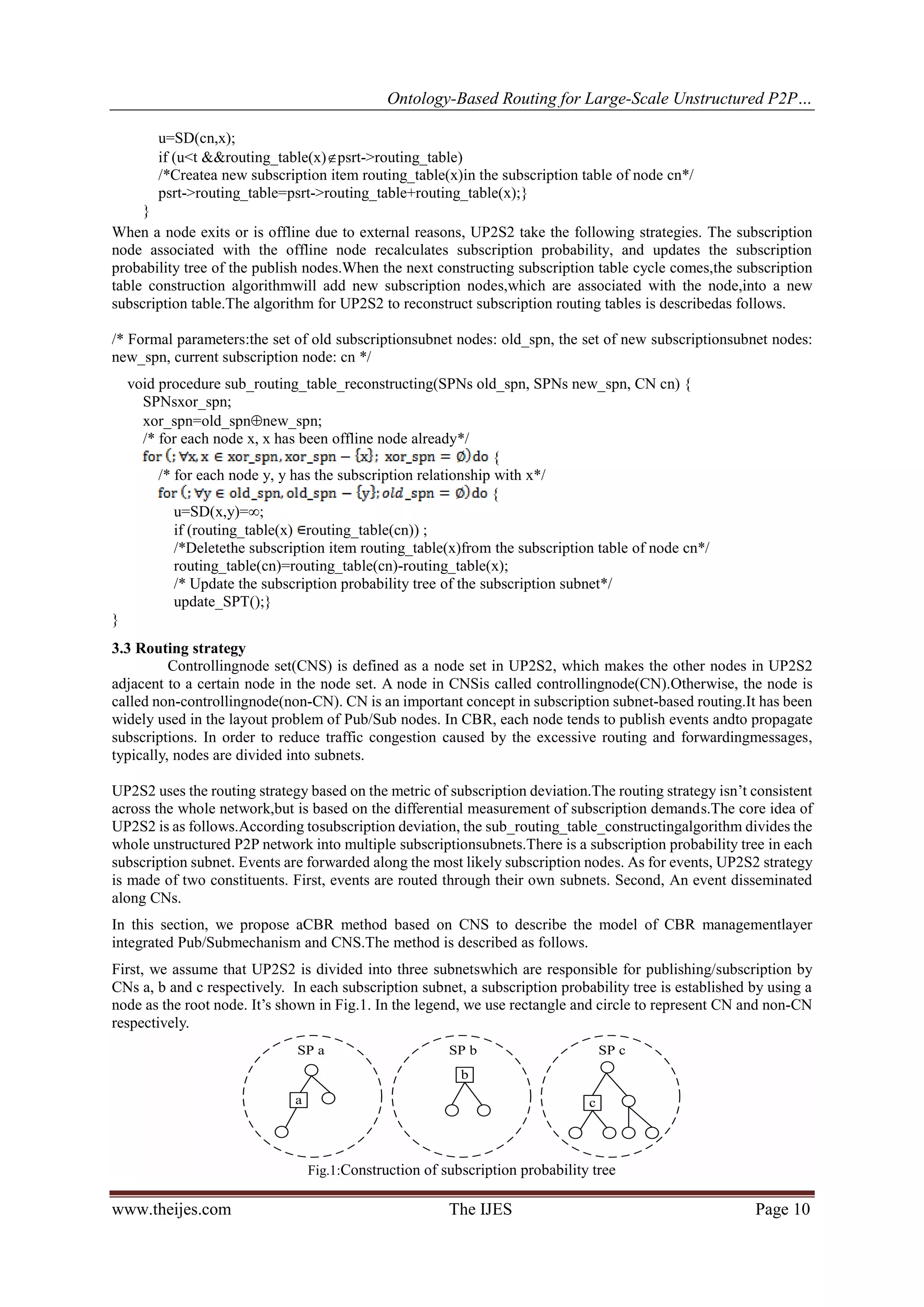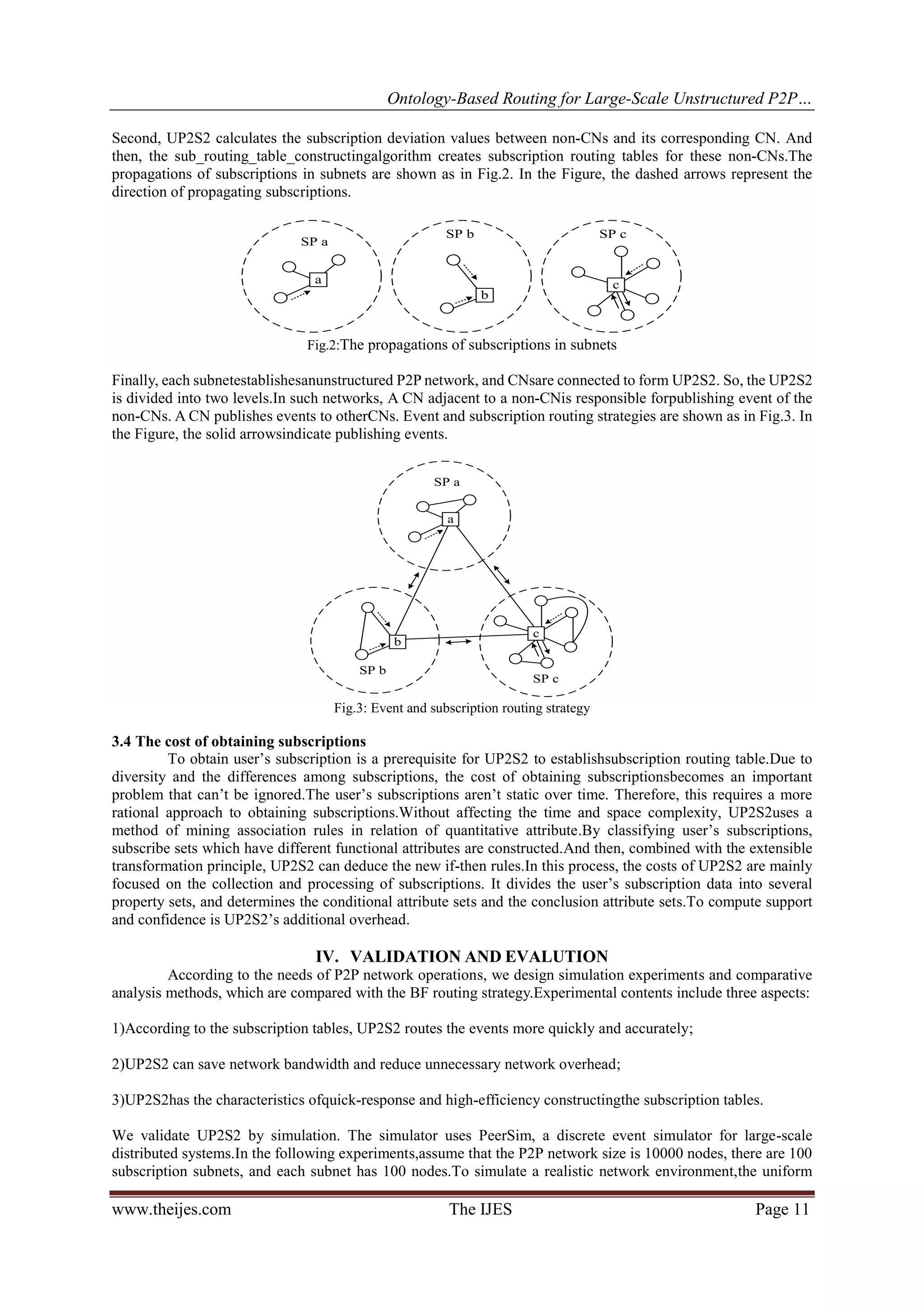The document presents UP2S2, an ontology-based routing mechanism for large-scale unstructured peer-to-peer (P2P) publish/subscribe systems that improves event routing by constructing subscription probability trees and selecting optimal paths for event dissemination. The system divides the network into multiple subnets based on subscription deviation to enhance network efficiency and reduce bottlenecks typically found in structured P2P systems. Simulation results indicate that UP2S2 achieves faster and more accurate event routing compared to existing methods.
![The International Journal Of Engineering And Science (IJES)
|| Volume || 4 || Issue || 11 || Pages || PP -07-13|| 2015 ||
ISSN (e): 2319 – 1813 ISSN (p): 2319 – 1805
www.theijes.com The IJES Page 7
Ontology-Based Routing for Large-Scale Unstructured P2P
Publish/Subscribe System
1
Biao Dong, 2
Jinhui Chen
1
School of Computer & Software, Nanjing Institute of Industry Technology, Nanjing, China
2
School of Computer & Software, Nanjing University of Information Science & Technology, Nanjing, China
--------------------------------------------------------ABSTRACT-----------------------------------------------------------
Recent works in structured P2P systems exploit DHT to support publish/subscribe(Pub/Sub) protocols. Some of
these approaches require the existence of a so-called rendezvous node where subscriptions meet events, thus
easily creating bottlenecks. By contrast, unstructured P2P systems needn't maintain current topologies for the
networks, they are robust. We presents an ontology-based Pub/Sub event routing mechanism, called UP2S2, for
modeling and implementing the architecture of large-scale unstructured P2P Pub/Sub System. According to
subscription deviation, UP2S2 is divided into multiple subnets. There is a subscription probability tree in each
subscription subnet. Events are forwarded along the most likely subscription nodes. We design and implement the
algorithms for UP2S2 to construct and reconstruct subscription routing tables, and derive conclusions from the
simulation experiments. The results show that UP2S2 routes the events more quickly and accurately.
Keywords–LargeScale, P2P, Publish/Subscribe, Routing, Ontology
---------------------------------------------------------------------------------------------------------------------------------------
Date of Submission: 14 November 2015 Date of Accepted: 30 November 2015
---------------------------------------------------------------------------------------------------------------------------------------
I. INTRODUCTION
Pub/Sub is an asynchronous communication paradigm that supports many-to-many interactions between
a set of clients. Pub/Sub communication can be anonymous, where participants are decoupled from space, flow,
and time. A Pub/Sub system contains three kinds of clients: a publisher who publishes events, a subscriber who
subscribes his interests to the system, and an event broker network to match and deliver the events to the
corresponding subscribers. When an event is published, a Pub/Sub system doesn’t specify a specific subscriber.
After each agent node receives an event, it decides which nodes should be propagated in the next step. Therefore,
routing of Pub/Sub system is also called content-based routing(CBR). Routing algorithm resolves how to find an
appropriate path in event broker networks, and how to efficiently and reliably route event to the relevant
subscribers at a low cost. Both accuracy of event routing and network efficiency are the most important design
goals, which determines the size and scalability of the network.
P2P networking is a distributed application architecture that subnets tasks or work-loads between peers. We can
classify networks as unstructured or structured. Structured P2P systems impose a specific linkage structure
between nodes. In contrast, in unstructured P2P systems, peers are not linked according to a predefined
deterministic scheme. Instead, links are created either randomly, or are probabilistically based on some proximity
metric between nodes. Because of its advantages, such as rapid information dissemination, and content-based
routing, unstructured P2P network has been used to construct the Pub/Sub system in order to improve the ability to
improve the efficiency for event routing.
The rest of the paper is organized as follows. In Section 2, we review some related works. Our main methods
including the algorithms for constructing and reconstructing subscription routing tables in UP2S2 are presented in
Section 3. Both validations and evaluations are given in Section 4. Finally, the paper is concluded in Section 5.
II. RELATED WORK
Enabling the Pub/Sub services in P2P systems has thus become an interesting topic in recent years. The
structured P2P system has its advantage in searching efficiency. To provide subject-based Pub/Sub services, data
and queries with a certain topic can be easily mapped and routed to the same node using DHT. Chaabane proposed
an approach based on a community-wide ontology in order to allow publishers and subscribers to use a common
semantic space to characterize production and consumption of resources and services. Based on this ontology,
these ontology-based community topics are used to compute keys for routing events in a DHT[1]. Setty presented
PolderCast, a P2P architecture for topic-based Pub/Sub which aims to achieve relay-free, fast and robust](https://image.slidesharecdn.com/b04110307013-151205062450-lva1-app6891/75/Ontology-Based-Routing-for-Large-Scale-Unstructured-P2P-Publish-Subscribe-System-1-2048.jpg)
![Ontology-Based Routing for Large-Scale Unstructured P2P…
www.theijes.com The IJES Page 8
dissemination over a scalable overlay with a minimal maintenance cost[2]. Pandey presented the architecture of
distributed mobile brokers which are dynamically reconfigurable in the form of structured P2P overlay and act as
rendezvous points for matching publications and subscriptions[3]. Pellegrino introduced two versions of a
content-based Pub/Sub matching algorithm for RDF described events, working on an adapted version of the CAN
structured P2P network designed to both store and disseminate RDF events[4]. Einziger introduced Postman, a
Pub/Sub architecture tailored for self-sustained service independent P2P networks. Postman is designed to
provide its users with a self-organizing, scalable, efficient and churn resilient Pub/Sub service[5]. Detti discussed
the benefits of building mobile Ad-hoc networks Pub/Sub system exploiting content centric networking
technology, rather than TCP/IP, and presented different design approaches, and described a topic-based Pub/Sub
content centric networking system[6]. Tryfonopoulos studied the problem of distributed resource sharing in p2p
networks, focused on the problem of information filtering, used an extension of the DHT Chord to organize the
nodes and store user subscriptions, and utilized efficient publication protocols that keep the network traffic and
latency low at filtering time[7].
Compared with the structured P2P-based Pub/Sub system, the unstructured Pub/Sub services can be provided on
deliberately designed overlay topologies. In unstructured P2P systems, subscribers and publishers rely on
distributing the queries and data messages throughout the network to make a successful subscription. Rahimian
introduced Vitis that exploits two ostensibly opposite mechanisms: unstructured clustering of similar peers and
structured rendezvous routing. A gossiping technique was embedded a navigable small-world network, which
efficiently establishes connectivity among clusters of nodes that exhibit similar subscriptions[8]. Chacko
proposed a CoQUOS approach, which supports continuous queries in unstructured P2P networks. In order to
solve this problem of flexibility and complexity, proposing an approach of CoQUOS with consistency
maintenance[9]. Papadakis proposed ITA, an algorithm which creates a random overlay of randomly connected
neighborhoods providing topology awareness to P2P systems, while at the same time has no negative effect on the
self-* properties or the operation of the other P2P algorithms[10]. Klusch presented the mobile system, MyMedia,
which features a high-performance semantic P2P search and a dynamic adaptive live streaming of annotated
MPEG-DASH videos from mobile to mobile devices over HTTP in wireless networks with an unstructured and
semantic P2P overlay[11]. Baraglia proposed a general architecture of a system whose aim is to exploit the
collaborative exchange of information between peers in order to build a system able to gather similar users and
spread useful suggestions among them, and presented mechanisms for building communities both in a simple way
and in a more complex way[12]. Margariti considered flooding, a fundamental mechanism for network discovery
and query routing, in unstructured P2P networks, and analyzed the behavior of flooding related to duplicate
messages and provide simple bounds and approximate models to assess the associated overheads[13]. Ferretti
analyzed the performance of an unstructured P2P overlay network that exploits a very simple dissemination
strategy to build P2P Pub/Sub systems. A mathematical analysis is provided to estimate the number of nodes
receiving the event[14]. Leng introduced both replica maintenance and update mechanisms for the BubbleStorm
P2P overlay and related rendezvous search systems. A complete solution covering all identified use cases included
a maintainer-based mechanism for data managed by a single node and a collective mechanism for data that shall
be persistent beyond any particular node’s session time[15].
Recent works in structured P2P systems exploit DHT to support CBR. Some of these approaches require the
existence of a so-called rendezvous node where subscriptions meet events, thus easily creating bottlenecks. By
contrast, unstructured P2P systems needn't maintain current topologies for the networks, they are robust. However,
the structured P2P systems are vulnerable to networks storm and data overlapping. In this paper, we propose a new
unstructured P2P system, suitable for large-scale Pub/Sub. The design guidelines are as follows.
1) We propose the concept of subscription ontology. Based on the similarity of the subnet, the unstructured P2P
network is divided into subnets.
2) Based on the subscription deviation, the routing strategies make the choice for event flooding route. The
strategies forward events to the most likely directions.
III. OURMETHODS
3.1 Subscription ontology
In information science, ontology is a formal naming and definition of the types, properties, and
interrelationships of the entities that really or fundamentally exist for a particulardomain of discourse. In an
ontology tree, each node represents an independent concept, each edge represents a directed edge from a parent
node to a child node, and child nodes represent sub-concepts of the correspondingparent nodes. In UP2S2, an](https://image.slidesharecdn.com/b04110307013-151205062450-lva1-app6891/75/Ontology-Based-Routing-for-Large-Scale-Unstructured-P2P-Publish-Subscribe-System-2-2048.jpg)




![Ontology-Based Routing for Large-Scale Unstructured P2P…
www.theijes.com The IJES Page 13
As shown in Figure 6,UP2S2 is better than BF in terms of subscription table construction time.Especially in the
number of events is small, subscription table construction time of UP2S2 is nearly 30% less than that of BF.
V. CONCLUSION
In this paper, we propose UP2S2, a large-scale ontology-based Pub/Sub for Unstructured P2P networks,
to provide the architecture of Pub/Subrouting. UP2S2is based on event and subscription subnet model. We design
and implement the algorithms for UP2S2 to construct and reconstruct subscription routing tables, and derive
conclusions from the simulation experiments. The results show that UP2S2 routes the events more quickly and
accurately.
ACKNOWLEDGEMENTS
This work was sponsored by Qing Lanproject(Jiangsu province, china) and open fund project of Jiangsu
provincial research and development center of intelligent sensor network engineering technology,
china(ZK13-02-03, Software technology, platform and application for sensor network)
REFERENCES
[1]A. Chaabane, W. Louati, M. Jmaiel, et al, Towards an ontology and DHT-based publish/subscribe scalable system, Communications (ICC),
2012 IEEE International Conference on. IEEE, Ottawa, Canada, 2012, 6499-6503.
[2]V. Setty, M. Van Steen, R. Vitenberg, et al,PolderCast: fast, robust, and scalable architecture for P2P topic-based pub/sub, Proceedings of
the 13th International Middleware Conference, Montreal, QC, Canada, 2012, 271-291.
[3]T. Pandey, D. Garg, and M.M. Gore, Structured P2P Overlay of Mobile Brokers for Realizing Publish/Subscribe Communication in
VANET,The Scientific World Journal, 2014.
[4]L. Pellegrino, F. Huet, F. Baude, et al, A Distributed Publish/Subscribe System for RDF Data, Data Management in Cloud, Grid and P2P
Systems: 6th International Conference, Globe 2013, Prague, Czech Republic, 2013, 8059:39.
[5]G. Einziger, R. Friedman, Postman: An Elastic Highly Resilient Publish/Subscribe Framework for Self Sustained Service Independent P2P
Networks, Stabilization, Safety, and Security of Distributed Systems: 16th International Symposium, Paderborn, Germany, 2014,
8756:78.
[6]A. Detti, D. Tassetto, N.B. Melazzi, et al, Exploiting content centric networking to develop topic-based, publish–subscribe MANET
systems,Ad Hoc Networks, 24, 2015,115-133.
[7]C. Tryfonopoulos, S. Idreos, M. Koubarakis, et al, Distributed large-scale information filtering, Transactions on Large-Scale Data-and
Knowledge-Centered Systems XIII, 2014, 91-122.
[8]F. Rahimian, S. Girdzijauskas, A.H. Payberah, et al,Vitis: A gossip-based hybrid overlay for internet-scale publish/subscribe enabling
rendezvous routing in unstructured overlay networks, Parallel & Distributed Processing Symposium, 2011 IEEE
International,Anchoraga, Alaska, USA, 2011, 746-757.
[9]A. Chacko, M.S. Sendil, and D.R.S. Karthik, Consistency Maintenance Of Continuous Queries In Unstructured Overlay
Networks,International Journal of Advanced Research in Computer Science and Electronics Engineering, 1(4), 2012, 84-88.
[10] H. Papadakis, P. Fragopoulou, E.P. Markatos, et al,Ita: innocuous topology awareness for unstructured P2P networks,Parallel and
Distributed Systems, IEEE Transactions, 24(8), 2013, 1589-1601.
[11] M. Klusch, P. Kapahnke, X. Cao, et al, MyMedia: mobile semantic peer-to-peer video search and live streaming, Proc. 11th
International Conference on Mobile and Ubiquitous Systems: Computing, Networking and Services, London, UK, 2014: 277-286.
[12] R. Baraglia, P. Dazzi, M. Mordacchini, et al, A peer-to-peer recommender system for self-emerging user communities based on gossip
overlays,Journal of Computer and System Sciences, 79(2), 2013, 291-308.
[13] S.V. Margariti, V.V. Dimakopoulos, A study on the redundancy of flooding in unstructured p2p networks, International Journal of
Parallel, Emergent and Distributed Systems, 28(3), 2013, 214-229.
[14] S. Ferretti, Publish-subscribe systems via gossip: a study based on complex networks, Proc. of the Fourth Annual Workshop on
Simplifying Complex Networks for Practitioners, Lyon,France, 2012, 7-12.
[15] C. Leng,BubbleStorm: replication, updates, and consistency in rendezvous information systems, doctoral diss., Darmstadt University of
Technology, Darmstadt, Germany, 2012.
AUTHORS
Biao Dong now is an Associate Professor in the School of Computer and Software at Nanjing Institute of Industry
Technology, Nanjing, China. He received his BS degree in Computer Application Technology from Nanjing
University, China (2001). He received his MS degree, and PhD degree in Computer Science and Technology from
the Hohai University, China (2004), Nanjing University of Science and Technology, China(2011), respectively.
His research interests include new services for wireless sensor and actuator networks, service provisioning and
management, advanced software architectures, and component-based distributed applications design.
Jinhui Chen currently is an Associate Professor and supervisor of graduate students in the School of Information
and Control, Nanjing University of Information Science & Technology (previously named Nanjing Institute of
Meteorology). She received her BS degree in Computer Science and Technology, MS degree in System Analysis
and Integration from Nanjing University of Information Science & Technology, China, in 1992 and 2002,
respectively. Her research interests include wireless networks, mobile computing, and approximation algorithm
design and analysis.](https://image.slidesharecdn.com/b04110307013-151205062450-lva1-app6891/75/Ontology-Based-Routing-for-Large-Scale-Unstructured-P2P-Publish-Subscribe-System-7-2048.jpg)